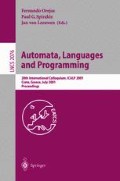Abstract
Classical Hausdorff dimension was recently effectivized using gales (betting strategies that generalize martingales), thereby endowing various complexity classes with dimension structure and also defining the constructive dimensions of individual binary (infinite) sequences. In this paper we use gales computed by multi-account finite-state gamblers to develop the finite-state dimensions of sets of binary sequences and individual binary sequences. Every rational sequence (binary expansion of a rational number) has finite-state dimension 0, but every rational number in [0; 1] is the finite-state dimension of a sequence in the low-level complexity class AC0. Our main theorem shows that the finite-state dimension of a sequence is precisely the infimum of all compression ratios achievable on the sequence by information-lossless finite-state compressors.
Access this chapter
Tax calculation will be finalised at checkout
Purchases are for personal use only
Preview
Unable to display preview. Download preview PDF.
References
É. Borel. Sur les probabilités dénombrables et leurs applications arithmétiques. Rend. Circ. Mat. Palermo, 27:247–271, 1909.
J. Cai and J. Hartmanis. On Hausdorff and topological dimensions of the Kolmogorov complexity of the real line. Journal of Computer and Systems Sciences, 49:605–619, 1994.
H.G. Eggleston. The fractional dimension of a set defined by decimal properties. Quarterly Journal of Mathematics, Oxford Series 20:31–36, 1949.
K. Falconer. The Geometry of Fractal Sets. Cambridge University Press, 1985.
M. Feder. Gambling using a finite state machine. IEEE Transactions on Information Theory, 37:1459–1461, 1991.
F. Hausdorff. Dimension und äusseres Mass. Math. Ann., 79:157–179, 1919.
D. A. Huffman. Canonical forms for information-lossless finite-state logical machines. IRE Trans. Circuit Theory CT-6 (Special Supplement), pages 41–59, 1959. Also avalaible in E.F. Moore (ed.), Sequential Machine: Selected Papers, Addison-Wesley, 1964, pages 866-871.
Z. Kohavi. Switching and Finite Automata Theory (Second Edition). McGraw-Hill, 1978.
A. A. Kurmit. Information-Lossless Automata of Finite Order. Wiley, 1974.
Lathrop and Strauss. A universal upper bound on the performance of the Lempel-Ziv algorithm on maliciously-constructed data. In SEQS: Sequences’ 97, 1997.
J. H. Lutz. Dimension in complexity classes. In Proceedings of the Fifteenth Annual IEEE Conference on Computational Complexity, pages 158–169. IEEE Computer Society Press, 2000.
J. H. Lutz. Gales and the constructive dimension of individual sequences. In Proceedings of the 27th Colloquium on Automata, Languages and Programming, pages 902–913. Springer Lecture Notes in Computer Science, 2000.
B. Ya. Ryabko. Noiseless coding of combinatorial sources. Problems of Information Transmission, 22:170–179, 1986.
B. Ya. Ryabko. Algorithmic approach to the prediction problem. Problems of Information Transmission, 29:186–193, 1993.
B. Ya. Ryabko. The complexity and effectiveness of prediction problems. Journal of Complexity, 10:281–295, 1994.
C. P. Schnorr and H. Stimm. Endliche automaten und zufallsfolgen. Acta Informatica, 1:345–359, 1972.
L. Staiger. Kolmogorov complexity and Hausdorff dimension. Information and Computation, 102:159–194, 1993.
L. Staiger. A tight upper bound on Kolmogorov complexity and uniformly optimal prediction. Theory of Computing Systems, 31:215–229, 1998.
J. Ziv. Coding theorem for individual sequences. IEEE Transactions on Information Theory, 24:405–412, 1978.
Author information
Authors and Affiliations
Editor information
Editors and Affiliations
Rights and permissions
Copyright information
© 2001 Springer-Verlag Berlin Heidelberg
About this paper
Cite this paper
Dai, J.J., Lathrop, J.I., Lutz, J.H., Mayordomo, E. (2001). Finite-State Dimension. In: Orejas, F., Spirakis, P.G., van Leeuwen, J. (eds) Automata, Languages and Programming. ICALP 2001. Lecture Notes in Computer Science, vol 2076. Springer, Berlin, Heidelberg. https://doi.org/10.1007/3-540-48224-5_83
Download citation
DOI: https://doi.org/10.1007/3-540-48224-5_83
Published:
Publisher Name: Springer, Berlin, Heidelberg
Print ISBN: 978-3-540-42287-7
Online ISBN: 978-3-540-48224-6
eBook Packages: Springer Book Archive

